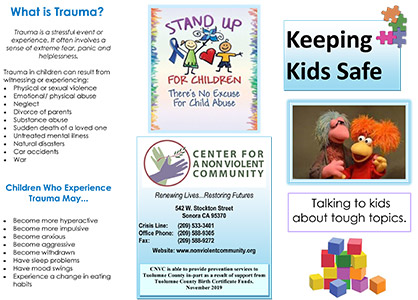The Center For A Non Violent Community has provided the Keeping Kids Safe (KKS) program to pre-school through third-grade students since 1997. The program utilizes puppet shows, songs, books, and guided discussions to help children learn the following: How to stay safe, identification of private body parts, the difference between a safe touch and a hurtful touch, and “Say No, Get Away, and Tell Someone” strategies for staying safe and getting help. Visit our YouTube page for more videos with Mikey as well “Keeping Kids Safe Story Time.”
Understanding how to prevent child sexual abuse begins with understanding what child sex abuse is. When parents, caregivers, treatment providers, child protection professionals and all adults in a position to protect a child keep informed about the facts related to sex abuse, then stepping up to take a protective action becomes easier and better defined.
All sexual touching between an adult and a child is sexual abuse. Sexual touching between children can also be sexual abuse when there is a significant age difference (often defined as 3 or more years) between the children or if the children are very different developmentally or size-wise. Sexual abuse does not have to involve penetration, force, pain, or even touching. If an adult engages in any sexual behavior (looking, showing, or touching) with a child to meet the adult’s interest or sexual needs, it is sexual abuse. This includes the manufacture, distribution and viewing of child pornography.
- One in 10 children will experience contact sexual abuse in the U.S. before age 18.
- More than 50% of sex abuse survivors were sexually abused before the age of 12.
- One in 25 children (10-17) will receive an online sexual solicitation
- Children with intellectual and mental health disabilities appear to be the most at risk, with 4.6 times the risk of sexual abuse as their peers without disabilities.
- In as many as 93 percent of child sexual cases, the child knows the person that commits the abuse.
- 60% of children who are sexually abused do not disclose.
Data from www.stopitnow.org.
Understanding Children’s Sexual Behaviors
What ARE safe and healthy sexual behaviors?
- Having questions and expressing knowledge relating to:
- Differences in gender, private body parts
- Hygiene and toileting
- Pregnancy and birth
- Exploring own genitals—can experience pleasure
- Curiosity to show or look at private body parts
- Experimenting with same-age and same gender children, often during games or role-playing
When are sexual behaviors NOT Safe and Healthy?
- Having knowledge of specific sexual acts or explicit sexual language
- Engaging in adult-like sexual contact with other children
- Behaving sexually in a public place or through use of phone or Internet
- Sexual Interest directed toward much younger children
What Adults Can Do
Help children feel safe
When children receive loving care they are more likely to feel safe and secure with the adults who take care of them.
Talk to the child.
Help them understand why they feel and behave a certain way indifferent situations.
Calmly listen to the child and answer questions.
Try to be comforting and supportive, avoid shaming.
Don’t be afraid to talk about a traumatic event.
Remain calm, and tell the child they did the right thing by coming to you.
The child will need to hear that you believe them (even if it is hard for you to accept).
Assure the child that you will do everything possible to keep them safe.
Do the best you can and get help. Call CNVC at 209-533-3401 or visit www.stopitnow.org.
If you believe the child is in danger, call law enforcement.
Simple steps to teach children how to stay safe
Tell the child: “Your body belongs to you.” No one has the right to touch or see your private parts unless it’s to keep to keep you clean or healthy.
Teach the following Safety Steps:
1. Say No to an uncomfortable situation
2. Get Away and seek a safe adult
3. Tell Someone they trust what happened and out how it made them feel

